engine coolant CADILLAC XT5 2020 User Guide
[x] Cancel search | Manufacturer: CADILLAC, Model Year: 2020, Model line: XT5, Model: CADILLAC XT5 2020Pages: 384, PDF Size: 6.52 MB
Page 263 of 384
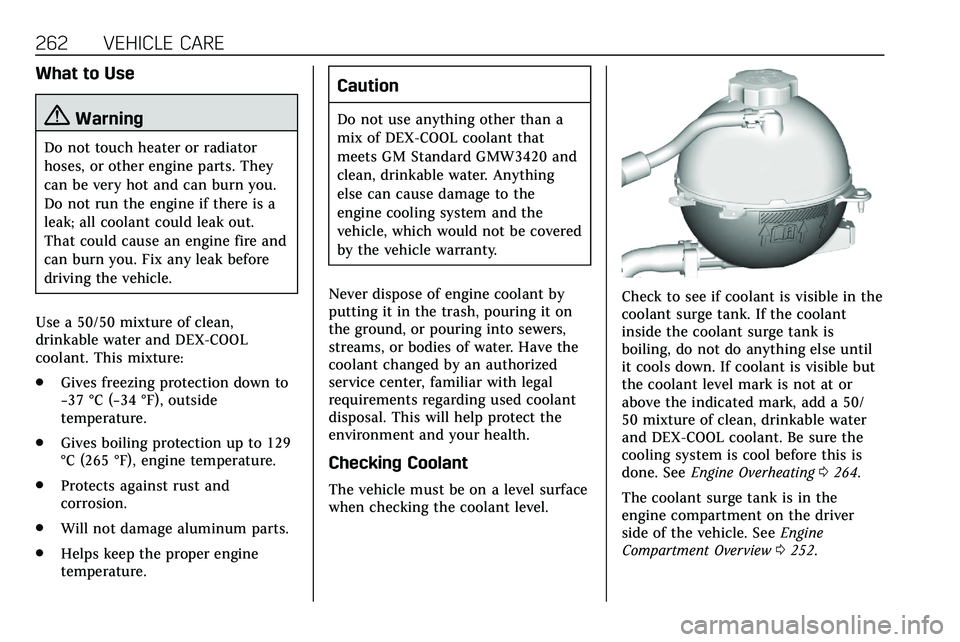
262 VEHICLE CARE
What to Use
{Warning
Do not touch heater or radiator
hoses, or other engine parts. They
can be very hot and can burn you.
Do not run the engine if there is a
leak; all coolant could leak out.
That could cause an engine fire and
can burn you. Fix any leak before
driving the vehicle.
Use a 50/50 mixture of clean,
drinkable water and DEX-COOL
coolant. This mixture:
. Gives freezing protection down to
−37 °C (−34 °F), outside
temperature.
. Gives boiling protection up to 129
°C (265 °F), engine temperature.
. Protects against rust and
corrosion.
. Will not damage aluminum parts.
. Helps keep the proper engine
temperature.
Caution
Do not use anything other than a
mix of DEX-COOL coolant that
meets GM Standard GMW3420 and
clean, drinkable water. Anything
else can cause damage to the
engine cooling system and the
vehicle, which would not be covered
by the vehicle warranty.
Never dispose of engine coolant by
putting it in the trash, pouring it on
the ground, or pouring into sewers,
streams, or bodies of water. Have the
coolant changed by an authorized
service center, familiar with legal
requirements regarding used coolant
disposal. This will help protect the
environment and your health.
Checking Coolant
The vehicle must be on a level surface
when checking the coolant level.
Check to see if coolant is visible in the
coolant surge tank. If the coolant
inside the coolant surge tank is
boiling, do not do anything else until
it cools down. If coolant is visible but
the coolant level mark is not at or
above the indicated mark, add a 50/
50 mixture of clean, drinkable water
and DEX-COOL coolant. Be sure the
cooling system is cool before this is
done. See Engine Overheating 0264.
The coolant surge tank is in the
engine compartment on the driver
side of the vehicle. See Engine
Compartment Overview 0252.
Page 264 of 384

VEHICLE CARE 263
How to Add Coolant to the
Surge Tank
{Warning
Spilling coolant on hot engine parts
can burn you. Coolant contains
ethylene glycol and it will burn if
the engine parts are hot enough.
{Warning
Steam and scalding liquids from a
hot cooling system are under
pressure. Turning the pressure cap,
even a little, can cause them to
come out at high speed and you
could be burned. Never turn the cap
when the cooling system, including
the pressure cap, is hot. Wait for
the cooling system and pressure
cap to cool.
Caution
Failure to follow the specific
coolant fill procedure could cause
the engine to overheat and could
cause system damage. If coolant is
not visible in the surge tank,
contact your dealer.
The coolant surge tank pressure cap
can be removed when the cooling
system, including the surge tank
pressure cap and upper radiator hose,
is no longer hot.
Coolant Fill Instructions (3.6L
Engine Only)
1. Turn the pressure cap slowly counterclockwise. If a hiss is
heard, wait for that to stop.
A hiss means there is still some
pressure left. 2. Keep turning the pressure cap
slowly and remove it.
3. Fill the coolant surge tank withthe proper mixture to the mark
pointed to on the front of the
coolant surge tank.
4. With the coolant surge tank pressure cap off, start the engine
and let it run until you can feel
the upper radiator hose getting
hot. Watch out for the engine
cooling fans. By this time, the
coolant level inside the coolant
surge tank may be lower. If the
level is lower, add more of the
proper mixture to the coolant
Page 265 of 384
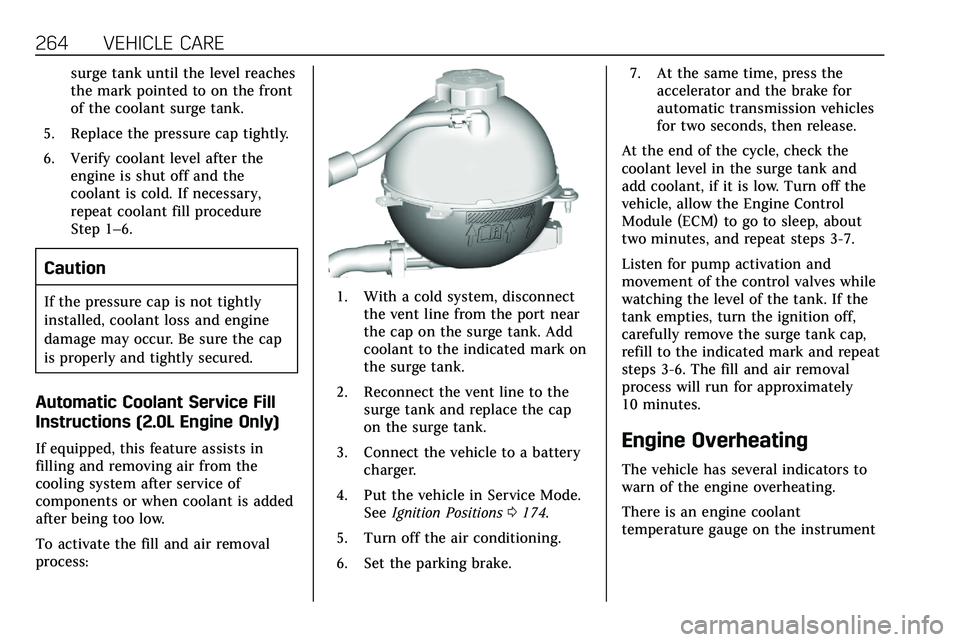
264 VEHICLE CARE
surge tank until the level reaches
the mark pointed to on the front
of the coolant surge tank.
5. Replace the pressure cap tightly.
6. Verify coolant level after the engine is shut off and the
coolant is cold. If necessary,
repeat coolant fill procedure
Step 1–6.
Caution
If the pressure cap is not tightly
installed, coolant loss and engine
damage may occur. Be sure the cap
is properly and tightly secured.
Automatic Coolant Service Fill
Instructions (2.0L Engine Only)
If equipped, this feature assists in
filling and removing air from the
cooling system after service of
components or when coolant is added
after being too low.
To activate the fill and air removal
process:
1. With a cold system, disconnectthe vent line from the port near
the cap on the surge tank. Add
coolant to the indicated mark on
the surge tank.
2. Reconnect the vent line to the surge tank and replace the cap
on the surge tank.
3. Connect the vehicle to a battery charger.
4. Put the vehicle in Service Mode. See Ignition Positions 0174.
5. Turn off the air conditioning.
6. Set the parking brake. 7. At the same time, press the
accelerator and the brake for
automatic transmission vehicles
for two seconds, then release.
At the end of the cycle, check the
coolant level in the surge tank and
add coolant, if it is low. Turn off the
vehicle, allow the Engine Control
Module (ECM) to go to sleep, about
two minutes, and repeat steps 3-7.
Listen for pump activation and
movement of the control valves while
watching the level of the tank. If the
tank empties, turn the ignition off,
carefully remove the surge tank cap,
refill to the indicated mark and repeat
steps 3-6. The fill and air removal
process will run for approximately
10 minutes.
Engine Overheating
The vehicle has several indicators to
warn of the engine overheating.
There is an engine coolant
temperature gauge on the instrument
Page 266 of 384
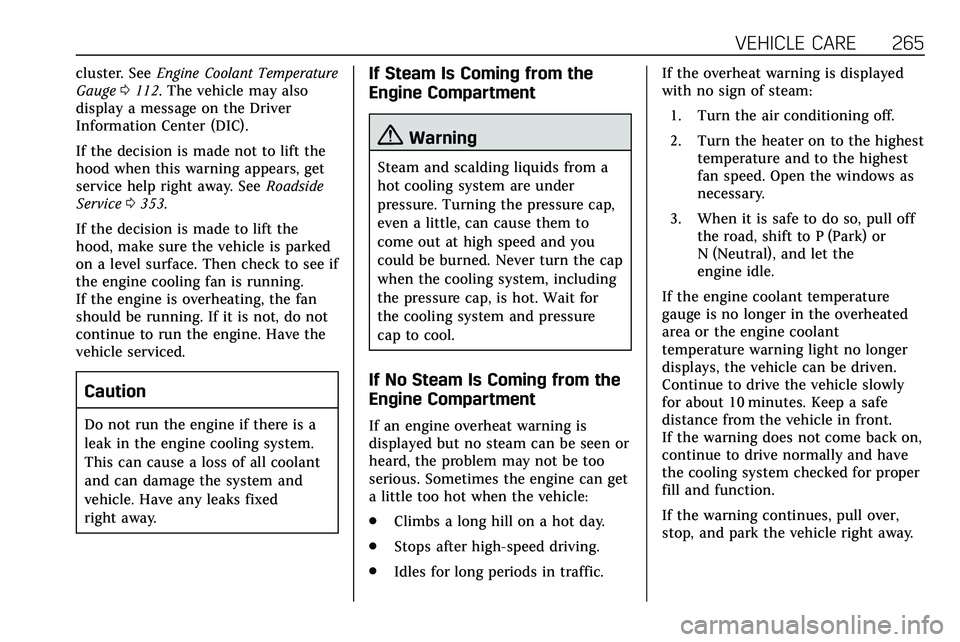
VEHICLE CARE 265
cluster. SeeEngine Coolant Temperature
Gauge 0112. The vehicle may also
display a message on the Driver
Information Center (DIC).
If the decision is made not to lift the
hood when this warning appears, get
service help right away. See Roadside
Service 0353.
If the decision is made to lift the
hood, make sure the vehicle is parked
on a level surface. Then check to see if
the engine cooling fan is running.
If the engine is overheating, the fan
should be running. If it is not, do not
continue to run the engine. Have the
vehicle serviced.
Caution
Do not run the engine if there is a
leak in the engine cooling system.
This can cause a loss of all coolant
and can damage the system and
vehicle. Have any leaks fixed
right away.
If Steam Is Coming from the
Engine Compartment
{Warning
Steam and scalding liquids from a
hot cooling system are under
pressure. Turning the pressure cap,
even a little, can cause them to
come out at high speed and you
could be burned. Never turn the cap
when the cooling system, including
the pressure cap, is hot. Wait for
the cooling system and pressure
cap to cool.
If No Steam Is Coming from the
Engine Compartment
If an engine overheat warning is
displayed but no steam can be seen or
heard, the problem may not be too
serious. Sometimes the engine can get
a little too hot when the vehicle:
. Climbs a long hill on a hot day.
. Stops after high-speed driving.
. Idles for long periods in traffic. If the overheat warning is displayed
with no sign of steam:
1. Turn the air conditioning off.
2. Turn the heater on to the highest temperature and to the highest
fan speed. Open the windows as
necessary.
3. When it is safe to do so, pull off the road, shift to P (Park) or
N (Neutral), and let the
engine idle.
If the engine coolant temperature
gauge is no longer in the overheated
area or the engine coolant
temperature warning light no longer
displays, the vehicle can be driven.
Continue to drive the vehicle slowly
for about 10 minutes. Keep a safe
distance from the vehicle in front.
If the warning does not come back on,
continue to drive normally and have
the cooling system checked for proper
fill and function.
If the warning continues, pull over,
stop, and park the vehicle right away.
Page 267 of 384
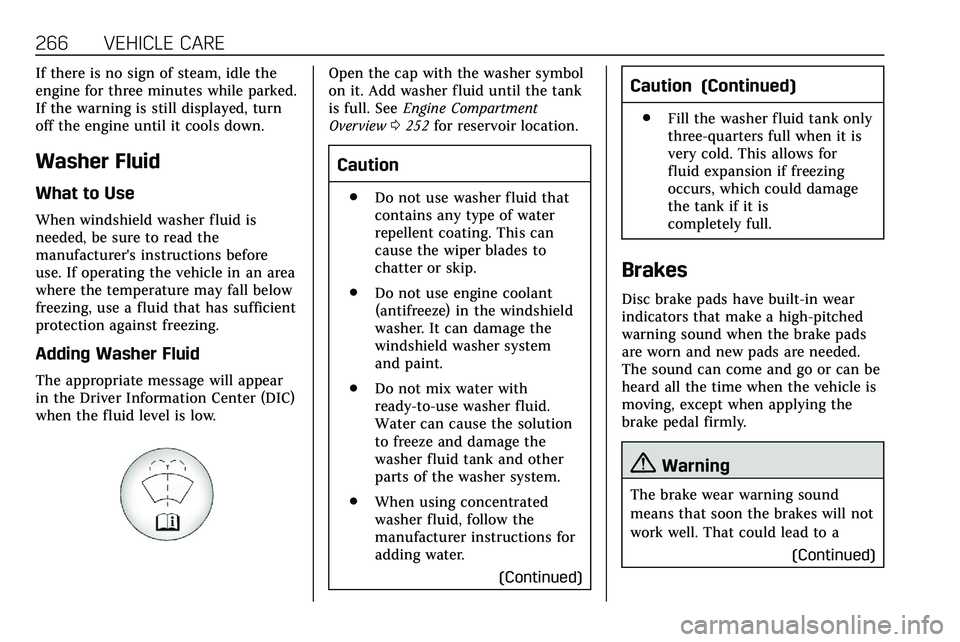
266 VEHICLE CARE
If there is no sign of steam, idle the
engine for three minutes while parked.
If the warning is still displayed, turn
off the engine until it cools down.
Washer Fluid
What to Use
When windshield washer fluid is
needed, be sure to read the
manufacturer's instructions before
use. If operating the vehicle in an area
where the temperature may fall below
freezing, use a fluid that has sufficient
protection against freezing.
Adding Washer Fluid
The appropriate message will appear
in the Driver Information Center (DIC)
when the fluid level is low.
Open the cap with the washer symbol
on it. Add washer fluid until the tank
is full. SeeEngine Compartment
Overview 0252 for reservoir location.
Caution
.
Do not use washer fluid that
contains any type of water
repellent coating. This can
cause the wiper blades to
chatter or skip.
. Do not use engine coolant
(antifreeze) in the windshield
washer. It can damage the
windshield washer system
and paint.
. Do not mix water with
ready-to-use washer fluid.
Water can cause the solution
to freeze and damage the
washer fluid tank and other
parts of the washer system.
. When using concentrated
washer fluid, follow the
manufacturer instructions for
adding water.
(Continued)
Caution (Continued)
.Fill the washer fluid tank only
three-quarters full when it is
very cold. This allows for
fluid expansion if freezing
occurs, which could damage
the tank if it is
completely full.
Brakes
Disc brake pads have built-in wear
indicators that make a high-pitched
warning sound when the brake pads
are worn and new pads are needed.
The sound can come and go or can be
heard all the time when the vehicle is
moving, except when applying the
brake pedal firmly.
{Warning
The brake wear warning sound
means that soon the brakes will not
work well. That could lead to a
(Continued)
Page 278 of 384

VEHICLE CARE 277
FusesUsage
F53 –
F54 Coolant pump
F55 –
F56 –
F57 Engine control module/Ignition
F58 Transmission control module/Ignition
F59 Engine control module battery
F60 –
F61 O2 sensor 1/ Aeroshutter
F62 Engine control module–odd
F63 O2 sensor 2
F64 Engine control module–even
F65 Engine control module powertrain 1
F66 Engine control module powertrain 2 Fuses
Usage
F67 Engine control module powertrain 3
F68 –
F69 –
F70 –
F71 –
F72 –
F73 –
F74 –
F75 –
F76 –
F77 –
Relays Usage
K1 Starter 1
K2 Run/Crank
K3 Starter 3
K4 LED/Automatic headlamps
K5 –
K6 Coolant pump Relays
Usage
K7 Engine control module
K8 Air conditioning
K9 –
K10 Starter 2
Instrument Panel Fuse
Block
The instrument panel fuse block is in
the center console between the driver
and passenger seats. To access the
Page 334 of 384
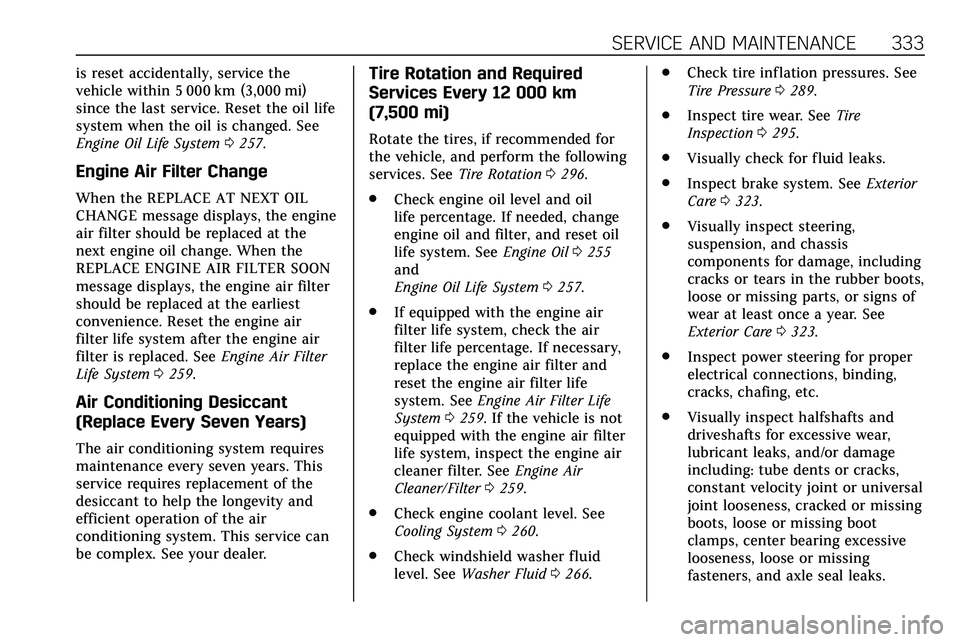
SERVICE AND MAINTENANCE 333
is reset accidentally, service the
vehicle within 5 000 km (3,000 mi)
since the last service. Reset the oil life
system when the oil is changed. See
Engine Oil Life System0257.
Engine Air Filter Change
When the REPLACE AT NEXT OIL
CHANGE message displays, the engine
air filter should be replaced at the
next engine oil change. When the
REPLACE ENGINE AIR FILTER SOON
message displays, the engine air filter
should be replaced at the earliest
convenience. Reset the engine air
filter life system after the engine air
filter is replaced. See Engine Air Filter
Life System 0259.
Air Conditioning Desiccant
(Replace Every Seven Years)
The air conditioning system requires
maintenance every seven years. This
service requires replacement of the
desiccant to help the longevity and
efficient operation of the air
conditioning system. This service can
be complex. See your dealer.
Tire Rotation and Required
Services Every 12 000 km
(7,500 mi)
Rotate the tires, if recommended for
the vehicle, and perform the following
services. See Tire Rotation0296.
. Check engine oil level and oil
life percentage. If needed, change
engine oil and filter, and reset oil
life system. See Engine Oil0255
and
Engine Oil Life System 0257.
. If equipped with the engine air
filter life system, check the air
filter life percentage. If necessary,
replace the engine air filter and
reset the engine air filter life
system. See Engine Air Filter Life
System 0259. If the vehicle is not
equipped with the engine air filter
life system, inspect the engine air
cleaner filter. See Engine Air
Cleaner/Filter 0259.
. Check engine coolant level. See
Cooling System 0260.
. Check windshield washer fluid
level. See Washer Fluid 0266. .
Check tire inflation pressures. See
Tire Pressure 0289.
. Inspect tire wear. See Tire
Inspection 0295.
. Visually check for fluid leaks.
. Inspect brake system. See Exterior
Care 0323.
. Visually inspect steering,
suspension, and chassis
components for damage, including
cracks or tears in the rubber boots,
loose or missing parts, or signs of
wear at least once a year. See
Exterior Care 0323.
. Inspect power steering for proper
electrical connections, binding,
cracks, chafing, etc.
. Visually inspect halfshafts and
driveshafts for excessive wear,
lubricant leaks, and/or damage
including: tube dents or cracks,
constant velocity joint or universal
joint looseness, cracked or missing
boots, loose or missing boot
clamps, center bearing excessive
looseness, loose or missing
fasteners, and axle seal leaks.
Page 343 of 384
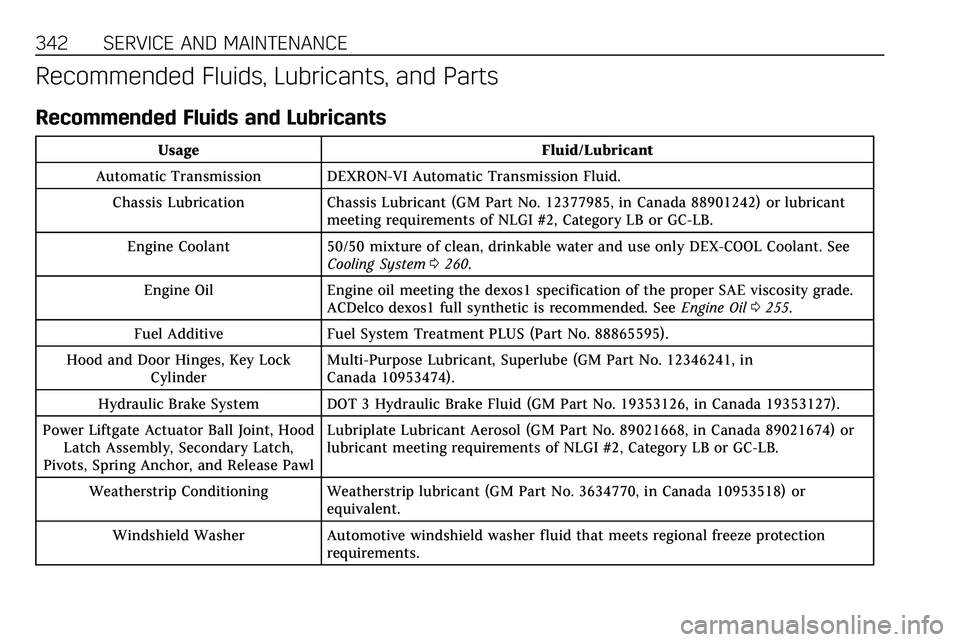
342 SERVICE AND MAINTENANCE
Recommended Fluids, Lubricants, and Parts
Recommended Fluids and Lubricants
UsageFluid/Lubricant
Automatic Transmission DEXRON-VI Automatic Transmission Fluid. Chassis Lubrication Chassis Lubricant (GM Part No. 12377985, in Canada 88901242) or lubricant
meeting requirements of NLGI #2, Category LB or GC-LB.
Engine Coolant 50/50 mixture of clean, drinkable water and use only DEX-COOL Coolant. See
Cooling System 0260.
Engine Oil Engine oil meeting the dexos1 specification of the proper SAE viscosity grade.
ACDelco dexos1 full synthetic is recommended. See Engine Oil0255.
Fuel Additive Fuel System Treatment PLUS (Part No. 88865595).
Hood and Door Hinges, Key Lock Cylinder Multi-Purpose Lubricant, Superlube (GM Part No. 12346241, in
Canada 10953474).
Hydraulic Brake System DOT 3 Hydraulic Brake Fluid (GM Part No. 19353126, in Canada 19353127).
Power Liftgate Actuator Ball Joint, Hood Latch Assembly, Secondary Latch,
Pivots, Spring Anchor, and Release Pawl Lubriplate Lubricant Aerosol (GM Part No. 89021668, in Canada 89021674) or
lubricant meeting requirements of NLGI #2, Category LB or GC-LB.
Weatherstrip Conditioning Weatherstrip lubricant (GM Part No. 3634770, in Canada 10953518) or equivalent.
Windshield Washer Automotive windshield washer fluid that meets regional freeze protection
requirements.
Page 375 of 384
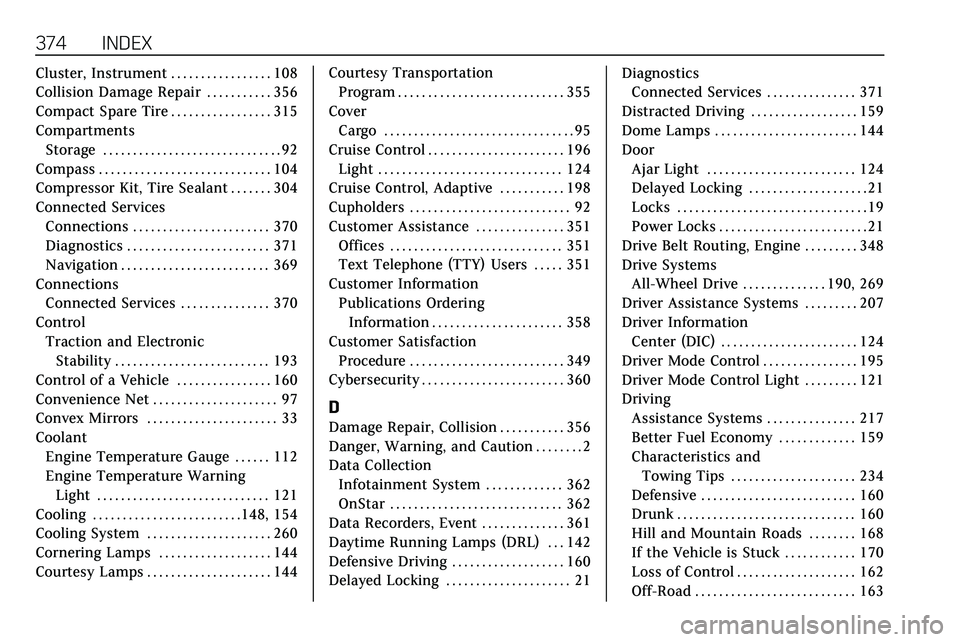
374 INDEX
Cluster, Instrument . . . . . . . . . . . . . . . . . 108
Collision Damage Repair . . . . . . . . . . . 356
Compact Spare Tire . . . . . . . . . . . . . . . . . 315
CompartmentsStorage . . . . . . . . . . . . . . . . . . . . . . . . . . . . . . 92
Compass . . . . . . . . . . . . . . . . . . . . . . . . . . . . . 104
Compressor Kit, Tire Sealant . . . . . . . 304
Connected Services Connections . . . . . . . . . . . . . . . . . . . . . . . 370
Diagnostics . . . . . . . . . . . . . . . . . . . . . . . . 371
Navigation . . . . . . . . . . . . . . . . . . . . . . . . . 369
Connections Connected Services . . . . . . . . . . . . . . . 370
Control Traction and ElectronicStability . . . . . . . . . . . . . . . . . . . . . . . . . . 193
Control of a Vehicle . . . . . . . . . . . . . . . . 160
Convenience Net . . . . . . . . . . . . . . . . . . . . . 97
Convex Mirrors . . . . . . . . . . . . . . . . . . . . . . 33
Coolant Engine Temperature Gauge . . . . . . 112
Engine Temperature Warning
Light . . . . . . . . . . . . . . . . . . . . . . . . . . . . . 121
Cooling . . . . . . . . . . . . . . . . . . . . . . . . .148, 154
Cooling System . . . . . . . . . . . . . . . . . . . . . 260
Cornering Lamps . . . . . . . . . . . . . . . . . . . 144
Courtesy Lamps . . . . . . . . . . . . . . . . . . . . . 144 Courtesy Transportation
Program . . . . . . . . . . . . . . . . . . . . . . . . . . . . 355
Cover Cargo . . . . . . . . . . . . . . . . . . . . . . . . . . . . . . . . 95
Cruise Control . . . . . . . . . . . . . . . . . . . . . . . 196 Light . . . . . . . . . . . . . . . . . . . . . . . . . . . . . . . 124
Cruise Control, Adaptive . . . . . . . . . . . 198
Cupholders . . . . . . . . . . . . . . . . . . . . . . . . . . . 92
Customer Assistance . . . . . . . . . . . . . . . 351
Offices . . . . . . . . . . . . . . . . . . . . . . . . . . . . . 351
Text Telephone (TTY) Users . . . . . 351
Customer Information Publications OrderingInformation . . . . . . . . . . . . . . . . . . . . . . 358
Customer Satisfaction Procedure . . . . . . . . . . . . . . . . . . . . . . . . . . 349
Cybersecurity . . . . . . . . . . . . . . . . . . . . . . . . 360
D
Damage Repair, Collision . . . . . . . . . . . 356
Danger, Warning, and Caution . . . . . . . . 2
Data Collection Infotainment System . . . . . . . . . . . . . 362
OnStar . . . . . . . . . . . . . . . . . . . . . . . . . . . . . 362
Data Recorders, Event . . . . . . . . . . . . . . 361
Daytime Running Lamps (DRL) . . . 142
Defensive Driving . . . . . . . . . . . . . . . . . . . 160
Delayed Locking . . . . . . . . . . . . . . . . . . . . . 21 Diagnostics
Connected Services . . . . . . . . . . . . . . . 371
Distracted Driving . . . . . . . . . . . . . . . . . . 159
Dome Lamps . . . . . . . . . . . . . . . . . . . . . . . . 144
Door Ajar Light . . . . . . . . . . . . . . . . . . . . . . . . . 124
Delayed Locking . . . . . . . . . . . . . . . . . . . . 21
Locks . . . . . . . . . . . . . . . . . . . . . . . . . . . . . . . . 19
Power Locks . . . . . . . . . . . . . . . . . . . . . . . . . 21
Drive Belt Routing, Engine . . . . . . . . . 348
Drive Systems All-Wheel Drive . . . . . . . . . . . . . . 190, 269
Driver Assistance Systems . . . . . . . . . 207
Driver Information Center (DIC) . . . . . . . . . . . . . . . . . . . . . . . 124
Driver Mode Control . . . . . . . . . . . . . . . . 195
Driver Mode Control Light . . . . . . . . . 121
Driving
Assistance Systems . . . . . . . . . . . . . . . 217
Better Fuel Economy . . . . . . . . . . . . . 159
Characteristics andTowing Tips . . . . . . . . . . . . . . . . . . . . . 234
Defensive . . . . . . . . . . . . . . . . . . . . . . . . . . 160
Drunk . . . . . . . . . . . . . . . . . . . . . . . . . . . . . . 160
Hill and Mountain Roads . . . . . . . . 168
If the Vehicle is Stuck . . . . . . . . . . . . 170
Loss of Control . . . . . . . . . . . . . . . . . . . . 162
Off-Road . . . . . . . . . . . . . . . . . . . . . . . . . . . 163
Page 376 of 384
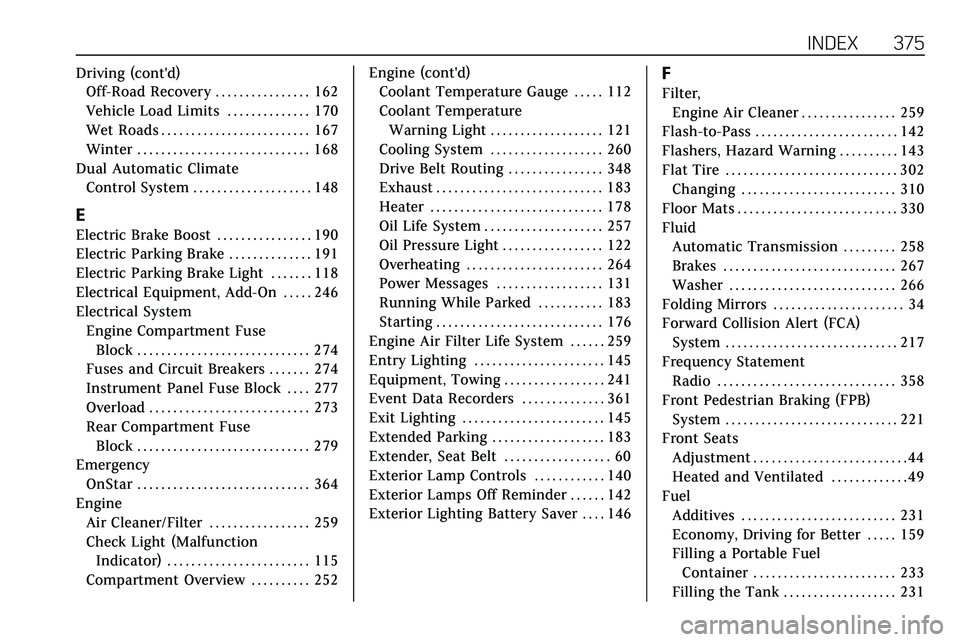
INDEX 375
Driving (cont'd)Off-Road Recovery . . . . . . . . . . . . . . . . 162
Vehicle Load Limits . . . . . . . . . . . . . . 170
Wet Roads . . . . . . . . . . . . . . . . . . . . . . . . . 167
Winter . . . . . . . . . . . . . . . . . . . . . . . . . . . . . 168
Dual Automatic Climate Control System . . . . . . . . . . . . . . . . . . . . 148
E
Electric Brake Boost . . . . . . . . . . . . . . . . 190
Electric Parking Brake . . . . . . . . . . . . . . 191
Electric Parking Brake Light . . . . . . . 118
Electrical Equipment, Add-On . . . . . 246
Electrical System
Engine Compartment FuseBlock . . . . . . . . . . . . . . . . . . . . . . . . . . . . . 274
Fuses and Circuit Breakers . . . . . . . 274
Instrument Panel Fuse Block . . . . 277
Overload . . . . . . . . . . . . . . . . . . . . . . . . . . . 273
Rear Compartment Fuse
Block . . . . . . . . . . . . . . . . . . . . . . . . . . . . . 279
Emergency
OnStar . . . . . . . . . . . . . . . . . . . . . . . . . . . . . 364
Engine Air Cleaner/Filter . . . . . . . . . . . . . . . . . 259
Check Light (MalfunctionIndicator) . . . . . . . . . . . . . . . . . . . . . . . . 115
Compartment Overview . . . . . . . . . . 252 Engine (cont'd)
Coolant Temperature Gauge . . . . . 112
Coolant Temperature
Warning Light . . . . . . . . . . . . . . . . . . . 121
Cooling System . . . . . . . . . . . . . . . . . . . 260
Drive Belt Routing . . . . . . . . . . . . . . . . 348
Exhaust . . . . . . . . . . . . . . . . . . . . . . . . . . . . 183
Heater . . . . . . . . . . . . . . . . . . . . . . . . . . . . . 178
Oil Life System . . . . . . . . . . . . . . . . . . . . 257
Oil Pressure Light . . . . . . . . . . . . . . . . . 122
Overheating . . . . . . . . . . . . . . . . . . . . . . . 264
Power Messages . . . . . . . . . . . . . . . . . . 131
Running While Parked . . . . . . . . . . . 183
Starting . . . . . . . . . . . . . . . . . . . . . . . . . . . . 176
Engine Air Filter Life System . . . . . . 259
Entry Lighting . . . . . . . . . . . . . . . . . . . . . . 145
Equipment, Towing . . . . . . . . . . . . . . . . . 241
Event Data Recorders . . . . . . . . . . . . . . 361
Exit Lighting . . . . . . . . . . . . . . . . . . . . . . . . 145
Extended Parking . . . . . . . . . . . . . . . . . . . 183
Extender, Seat Belt . . . . . . . . . . . . . . . . . . 60
Exterior Lamp Controls . . . . . . . . . . . . 140
Exterior Lamps Off Reminder . . . . . . 142
Exterior Lighting Battery Saver . . . . 146
F
Filter, Engine Air Cleaner . . . . . . . . . . . . . . . . 259
Flash-to-Pass . . . . . . . . . . . . . . . . . . . . . . . . 142
Flashers, Hazard Warning . . . . . . . . . . 143
Flat Tire . . . . . . . . . . . . . . . . . . . . . . . . . . . . . 302 Changing . . . . . . . . . . . . . . . . . . . . . . . . . . 310
Floor Mats . . . . . . . . . . . . . . . . . . . . . . . . . . . 330
Fluid Automatic Transmission . . . . . . . . . 258
Brakes . . . . . . . . . . . . . . . . . . . . . . . . . . . . . 267
Washer . . . . . . . . . . . . . . . . . . . . . . . . . . . . 266
Folding Mirrors . . . . . . . . . . . . . . . . . . . . . . 34
Forward Collision Alert (FCA) System . . . . . . . . . . . . . . . . . . . . . . . . . . . . . 217
Frequency Statement Radio . . . . . . . . . . . . . . . . . . . . . . . . . . . . . . 358
Front Pedestrian Braking (FPB) System . . . . . . . . . . . . . . . . . . . . . . . . . . . . . 221
Front Seats Adjustment . . . . . . . . . . . . . . . . . . . . . . . . . . 44
Heated and Ventilated . . . . . . . . . . . . . 49
Fuel Additives . . . . . . . . . . . . . . . . . . . . . . . . . . 231
Economy, Driving for Better . . . . . 159
Filling a Portable Fuel
Container . . . . . . . . . . . . . . . . . . . . . . . . 233
Filling the Tank . . . . . . . . . . . . . . . . . . . 231